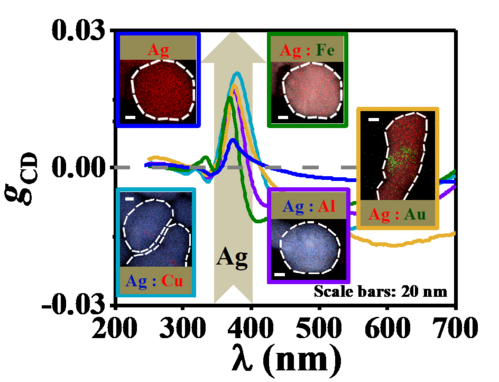HKBU researchers fabricate chiral nanoparticles composed of two metals with enhanced optical activity

Chirality, an asymmetric property that results in an object being non-superimposable on its mirror image, is a configurational property that generally occurs in molecular and biological systems, and plays a vital role in biochemical processes and functions closely related to public health.
Bulk metals are usually composed of close-packed crystal structures that are thermodynamically stable and lack the chirality. When bulk metals are sculptured into a helix with a characteristic helical pitch (P) shorter than 1 µm, i.e., nanohelix, chirality can be inherently imposed onto metals. Metal nanohelices show optical activity (that is, the differential interaction with left- and right-handed circularly polarized light), leading to various important applicants in the fields of drug delivery, bio-sensing, asymmetric synthesis, and light manipulation. High demand on biological applications essentially requires the shrinkage of P to be comparable to the sizes of biomolecules, i.e., P < 10 nm, to significantly enhance the chiral metal-biomolecule interactions. However, the sub-10-nm P unavoidably deteriorates the optical activity to severely limit the bio-application development. It is fundamentally important but very challenging to enhance the optical activity of metal nanohelices with the sub-10- nm P (or so-called chiral nanoparticles or CNPs).
Recently, Dr. Zhifeng Huang, Associate Professor in Department of Physics at HKBU, led an international team (with Prof. Utkur Mirsaidov, National University of Singapore) to devise a facile method to amplify the CNPs’ OA by alloying the host CNPs with solute metals through a three-step layer-by-layer glancing angle deposition (LbL-GLAD). This collaboration work was recently published in the renown journal Small (https://onlinelibrary.wiley.com/doi/abs/10.1002/smll.201906048).
The preparation process of this binary (or alloy composed of two kinds of metals) CNPs is similar to that of making "sandwiches". Two "bread" are composed of silver (Ag) CNPs, while the sandwiched "cheese" is made of a few nm-thick copper (Cu) thin film. Three GLAD steps were subsequently operated to fabricate the “sandwiches”, so-called LbL-GLAD. During the “sandwiching” process, the GLAD-induced heating causes the “cheese” to diffuse into the chiral “bread”. It results in the chiral alloying, where not only the solute Cu is induced to have the plasmonic optical activity, but also the formed alloys show amplified optical activity. Such chiral alloy has been demonstrated to be generally adapted to amplify the optical activity of CNPs made of diverse metals.
Additionally, the chiral alloying leads to an enhancement of refractive index sensitivity of metal CNPs. The alloy CNPs with amplified plasmonic optical activity pave the way towards potentially developing important public health-related applications in chiral drug production, disease diagnosis, and treatment.

